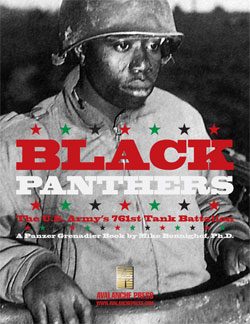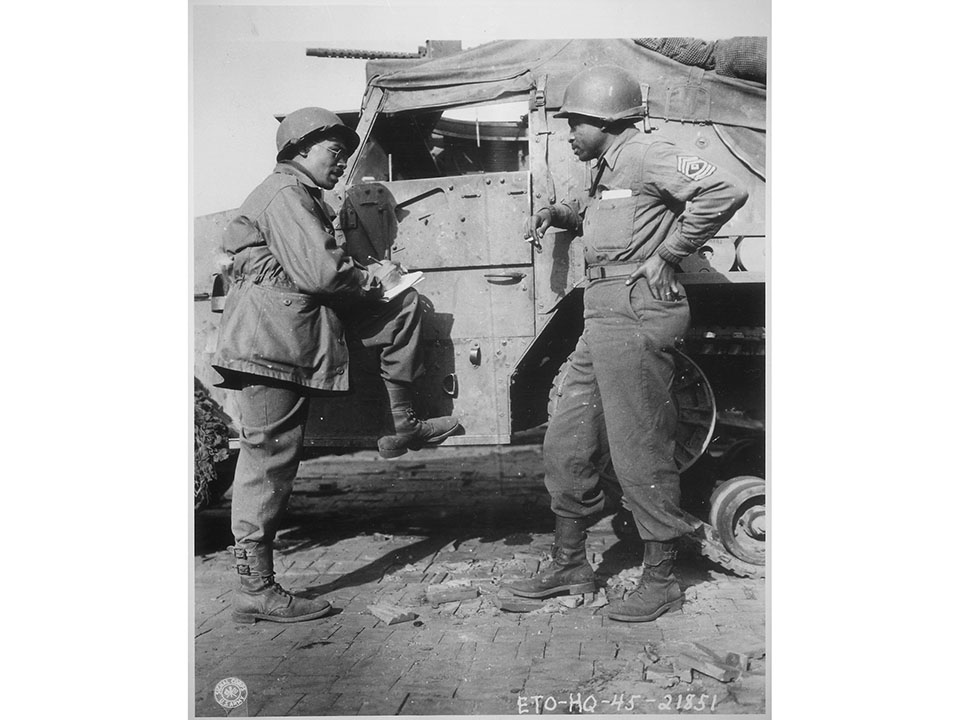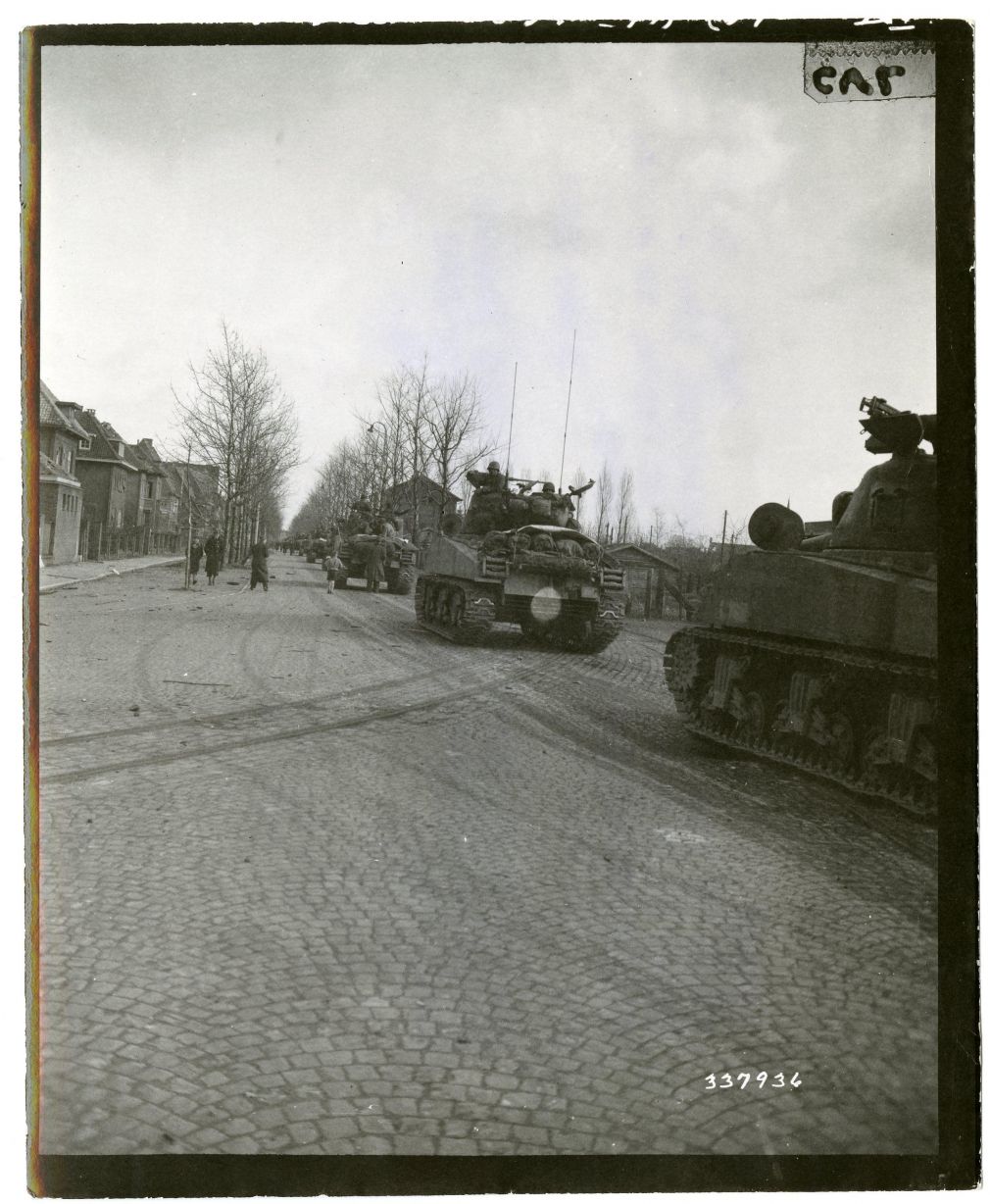| Black Panthers:
The Final Black Tank Battalion, Part 1
By Mike Bennighof, Ph.D.
August 2021
 The U.S. Army’s third segregated tank battalion, the 784th, came along well after the first two (the 758th and 761st). The battalion activated in April 1943, initially receiving its cadre of 19 officers and 99 enlisted men from the two already-existing Black battalions. Some personnel filtered in from the Armored Forces Replacement School but most came straight from basic training, with the majority of the initial intake made up of draftees from Mississippi. The U.S. Army’s third segregated tank battalion, the 784th, came along well after the first two (the 758th and 761st). The battalion activated in April 1943, initially receiving its cadre of 19 officers and 99 enlisted men from the two already-existing Black battalions. Some personnel filtered in from the Armored Forces Replacement School but most came straight from basic training, with the majority of the initial intake made up of draftees from Mississippi.
Initially the 784th organized at Camp Claiborne, Louisiana as a light tank battalion, equipped with three companies of M3 Stuart light tanks. It moved to Camp Hood, Texas in September and soon re-organized as a standard separate tank battalion, with three companies of M4 Sherman medium tanks and one of new M5 Stuart light tanks plus a Headquarters company with recon, mortar and assault gun (105mm-armed Shermans) platoons. The larger Sherman crews (five rather than four men) and additional company raised the table of organization from 550 to 750 men, and not until January 1944 did the battalion have all of its manpower.
As part of that reorganization, the 784th swapped some of its officers. Its Black officers, all of whom had come to the battalion in its initial cadre, returned to the 761st Tank Battalion. The 784th Tank Battalion would go to war with exclusively white officers.
Like the other two segregated tank battalions (all three together formed the 5th Tank Group), the 784th spent an extended time in training, as the U.S. Army’s leadership remained reluctant to commit Black units to combat. The 784th continued to train, including large-unit maneuvers, until receiving its alert for overseas deployment in June 1944. Black units typically had low priority for shipping, and not until November did the 784th arrive in Britain.
The battalion spent a month at Pontypridd in Wales, drawing new vehicles (M4A3 Shermans, with a 75mm gun, Ford gasoline engine and wet ammunition storage), training with them, and enraging white American soldiers by engaging in sex with white English women. Before serious incidents could take place, the battalion moved out for the French port of Rouen, six weeks after arriving in the United Kingdom.

Sgt. Morris Harris of the 784th Tank Battalion (right) tells his story to Ted Stanford of the weekly Pittsburgh Courier, one of two Black war correspondents in Europe.
From there, they commenced a road march to join the 104th “Timberwolves” Infantry Division, then holding a sector just to the north of the so-called Battle of the Bulge then raging in the Ardennes. After suffering some losses to bombing by the “American Luftwaffe” – casualties apparently not officially recorded by the U.S. Army – the battalion’s medium tanks operated in an artillery role for most of January 1945 before the 784th was attached to the 35th “Santa Fe” Infantry Division on 3 February.
The new assignment brought far more active combat. The Battle of the Bulge officially ended on 28 January, and the American divisions prepared to resume the offensive even as the weather remained vile. The 35th Infantry Division belonged to a different corps and army command, but was only about 15 miles down the Roer River from the 104th Infantry Division’s positions.
Operation Grenade would take the U.S. Ninth Army, reinforced by one corps from First Army, over the Roer River and across the Cologne Plain to the banks of the Rhine, where it would link up with the First Canadian Army. The Americans spent the first three weeks of February bringing up fresh troops, supplies and especially fuel and ammunition, and adjusting their divisions’ positions.
The 784th Tank Battalion had been portioned out among the 35th Infantry Division’s subordinate units, a common practice for the separate tank battalions attached to infantry divisions. Operation Grenade had been scheduled to jump off on 10 February, but a combination of heavy rains and broken dams turned the normally small and placid Roer River into a wide and raging torrent. Not until the night of 22-23 February did the assault begin, with a night-time crossing of the still-swollen Roer.
The tankers and infantry spent the extra time practicing assaults on concrete pillboxes, and the training paid off as the combined arms task forces quickly made progress against the unenthusiastic Volksgrenadiers holding the river line. The Santa Fe Division made its crossing on the 25th, with one of its regiments (and its attached company of 784th Shermans) first moving over the river into a neighboring division’s bridgehead to take the defenders in the flank. This was the Black battalion’s first serious combat experience, with both Able Company and the assault gun platoon providing point-blank support to take the fortified village of Hilfarth before the Germans could demolish its stone bridge.

Shermans of the 784th Tank Battalion on the mean streets of Venlo.
The tank-infantry teams worked well together, and by the 27th the division had cleared its sector of the Roer bridgehead. To exploit the breakthrough, the 35th Infantry Division built a motorized task force around its 320th Infantry Regiment, which had stood in reserve during the assault, and most of the 784th Tank Battalion, now operating together for one of the few times during the war. They struck directly northward for Venlo, a German-occupied Dutch city on the east bank of the Maas River, just inside the Dutch-German border. One battalion of infantry rode the tanks, with the other two in trucks. The rest of the division followed as best they could; although American infantry divisions included a great many trucks in their tables of organization, they were not fully motorized – not everyone and everything could ride at the same time.
The flying column brushed aside German resistance, offered by nearly-panicked Volksgrenadiers and mechanics-recently-turned-paratroopers. They met a wild welcome in Venlo, and then turned eastward back into Germany, where resistance stiffened. At the village of Sevelin, the advanced guard of the light tank company with the assault guns and some medium tanks, all carrying infantry, fell into a carefully-laid German ambush. After surviving an intense fight there, the battalion became far more cautious.
“Those Negro tankers fired on everything – houses, cows, men, vehicles, haystacks, barns, houses and other buildings,” noted the 320th Infantry’s intelligence officer, Capt. Orval Faubus, who would go on to become the viciously racist governor of Arkansas during the 1950’s. “The line of fires marked the path of their advance.”
At Kamperbruck, the ersatz paratroopers put up a serious fight, inflicting heavy casualties. Charlie Company lost all of its officers and six of its own tanks plus one attached light tank; several Black tankers were captured, tortured and executed by the Nazis. One of the Black platoon sergeants took command of the company and directed two attacks to try to rescue Lt. Art Solow, his platoon commander, who had been wounded but later died. Another platoon commander wounded in the battle, Lt. David Crawford, wrote later to company commander Capt. Donald Carman, also wounded, describing the effort. Crawford told Carman that he tried to obtain a battlefield commission and Silver Star for the sergeant named Burus, but the name and the recommendations do not appear in the 784th’s after action report.
All four companies saw intense action during the next several days, as German resistance stiffened and the rest of the 35th Infantry Division closed up with the flying column. After fighting for Wesel on the banks of the Rhine, the battalion pulled back into the Netherlands to absorb replacement tanks and perform maintenance.
You can order Black Panthers right here.
Please allow an additional three weeks for delivery.
Sign up for our newsletter right here. Your info will never be sold or transferred; we'll just use it to update you on new games and new offers.
Mike Bennighof is president of Avalanche Press and holds a doctorate in history from Emory University. A Fulbright Scholar and NASA Journalist in Space finalist, he has published an unknowable number of books, games and articles on historical subjects.
He lives in Birmingham, Alabama with his wife, three children and his dog, Leopold.
Want to keep Daily Content free of third-party ads? You can send us some love (and cash) through this link right here. |
